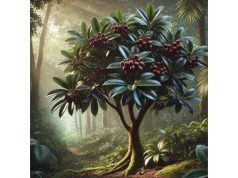Erythroxylum coca, commonly known as the coca plant, is a tropical shrub native to the Andean region of South America. Revered for centuries by indigenous cultures for its stimulating and medicinal properties, coca has a rich and complex history that spans traditional medicine, cultural rituals, and modern scientific inquiry. Although widely known for its role in the production of cocaine, the plant itself offers a wealth of benefits that extend far beyond its most infamous derivative. Traditionally, coca leaves were used by native peoples to combat fatigue, hunger, and altitude sickness, and were an integral part of daily life in Andean communities. Today, researchers are exploring the plant’s bioactive compounds to understand its potential for health and wellness applications. Erythroxylum coca’s stimulating alkaloids, combined with an impressive array of vitamins, minerals, and antioxidants, contribute to its reputation as a natural adaptogen and tonic.
The coca plant is characterized by its small, glossy leaves arranged alternately along its slender branches. Its leaves have a distinct, slightly bitter taste and a stimulating effect that has sustained Andean populations for generations. In traditional Andean society, coca was chewed, brewed into teas, or used in ceremonial practices to energize the body and mind. Beyond its stimulating effects, coca leaves are rich in essential nutrients and antioxidants, which support immune function, enhance endurance, and help protect against environmental stressors. Despite the controversies surrounding its use, a closer examination of Erythroxylum coca reveals a botanical treasure with multifaceted benefits that continue to influence modern research and applications.
- Boosts energy and reduces fatigue naturally
- Supports altitude adaptation and combats hunger
- Provides a rich source of vitamins, minerals, and antioxidants
- May enhance mental alertness and cognitive performance
- Offers potential anti-inflammatory and immune-supportive effects
Table of Contents
- Erythroxylum coca: Botanical Profile and Morphological Features
- Erythroxylum coca: Historical Legacy and Cultural Impact
- Erythroxylum coca: Phytochemical Profile and Active Compounds
- Erythroxylum coca: Therapeutic Benefits and Medicinal Attributes
- Erythroxylum coca: Practical Uses, Applications, and Safety Considerations
- Erythroxylum coca: Significant & Recent Scientific Studies
- Frequently Asked Questions about Erythroxylum coca
Erythroxylum coca: Botanical Profile and Morphological Features
Erythroxylum coca is a small, woody shrub that typically grows between 2 to 4 meters tall. Native to the Andean regions of South America, this tropical plant thrives in warm climates with well-drained soils at moderate altitudes. The plant is easily recognized by its slender branches, glossy green leaves, and clusters of small, star-shaped flowers. These morphological features not only define its aesthetic appeal but also play a vital role in its ecological adaptability.
Plant Structure and Appearance
Leaves:
The leaves of Erythroxylum coca are elliptical and oblong, with a smooth, glossy surface that reflects sunlight in its native highland environments. The leaf margins are slightly serrated, and their deep green color contributes to the plant’s overall visual appeal. Traditionally, coca leaves are harvested several times a year, and their fresh, natural state is key to preserving their bioactive properties.
Flowers:
Erythroxylum coca produces small, inconspicuous flowers that typically appear in clusters. The flowers are white or pale yellow with delicate petals that form a subtle star shape. While the flowers themselves may not be as visually striking as the leaves, they are crucial for the plant’s reproduction, attracting a variety of pollinators such as bees and other insects.
Fruits and Seeds:
After pollination, the plant forms small, capsule-like fruits that contain several seeds. These capsules mature quickly, allowing for the efficient spread of the plant in its native habitat. Seed dispersal is primarily achieved through wind and, in some cases, by animals that consume the fruit.
Growth Environment and Adaptations:
Erythroxylum coca is highly adaptable to its environment. It prefers well-drained soils and can be found in a range of habitats from subtropical forests to cultivated fields in the Andean region. Its ability to grow in diverse conditions is supported by an extensive root system that efficiently absorbs nutrients and water. Moreover, the plant’s tolerance to moderate altitudes has been a key factor in its cultural and historical significance in highland societies.
Ecological Role
In its natural habitat, Erythroxylum coca plays an important ecological role. Its dense foliage provides shelter and food for a variety of wildlife, while its flowers support pollinator populations. The plant’s deep roots help stabilize soil in the rugged Andean terrain, preventing erosion and maintaining the integrity of the local ecosystem. This ecological balance is crucial for sustaining the rich biodiversity found in these regions.
Horticultural and Economic Significance
Beyond its ecological importance, Erythroxylum coca is also significant for its economic and cultural value. The leaves of the coca plant have been harvested for centuries by indigenous communities for both their stimulating effects and their nutritional content. Today, despite the controversies surrounding its use in producing illicit substances, research into coca leaves continues to reveal potential health benefits and nutritional value, contributing to ongoing debates about its regulation and cultural importance.
Erythroxylum coca: Historical Legacy and Cultural Impact
The history of Erythroxylum coca is as complex as it is fascinating, woven deeply into the cultural fabric of Andean societies. For thousands of years, indigenous peoples have revered the coca plant not only for its stimulating effects but also as a sacred symbol of endurance, resilience, and the divine connection between humanity and nature.
Ancient Traditions and Uses
Cultural Rituals and Spiritual Significance:
In many Andean cultures, coca has been used in ceremonial practices and religious rituals. The leaves were considered a gift from the gods, and they played a central role in offerings, divination, and community celebrations. Shamans and healers often used coca in rituals to communicate with spiritual realms, seeking guidance and blessings for their people. The plant’s sacred status has been passed down through generations, preserving a deep respect for its natural properties.
Medicinal and Therapeutic Applications:
Historically, coca leaves were used in a variety of medicinal applications. Indigenous healers chewed the leaves to relieve hunger, fatigue, and altitude sickness—common challenges faced in the Andean highlands. Coca was also brewed into teas to support digestion, alleviate headaches, and enhance physical endurance. These traditional uses highlight the plant’s role as a natural tonic and adaptogen, capable of helping the body cope with the rigors of high-altitude life.
Economic and Social Importance:
Beyond its medicinal and spiritual uses, the coca plant has played a crucial economic role in Andean societies. It has been used as a form of currency and a trade commodity, fostering economic interactions among indigenous communities. The cultivation, processing, and distribution of coca leaves have historically contributed to local economies, reinforcing its importance as a cultural and economic asset.
Evolution of Coca in Modern History
The arrival of European colonizers in the Americas dramatically altered the traditional practices surrounding coca. Colonial authorities sought to control and exploit the plant, leading to significant cultural and economic shifts. Despite these challenges, the indigenous use of coca persisted, and in modern times, there has been a resurgence of interest in its traditional benefits. This renewed appreciation is reflected in contemporary debates about decriminalization and the potential medicinal applications of coca leaves in natural health products.
Contemporary Cultural Relevance
Today, Erythroxylum coca remains a potent symbol of cultural identity and resilience among Andean peoples. Efforts to preserve traditional coca cultivation and use are seen as vital for maintaining cultural heritage and biodiversity. Moreover, modern research into the nutritional and medicinal properties of coca leaves continues to shed light on their potential benefits, sparking discussions about their role in health and wellness outside of illicit contexts.
Erythroxylum coca: Phytochemical Profile and Active Constituents
Modern scientific investigations into Erythroxylum coca have revealed a complex array of bioactive compounds that underpin its diverse range of traditional uses. The phytochemical composition of coca leaves is responsible for both its stimulating effects and its potential therapeutic benefits, providing a scientific basis for many of the plant’s long-held cultural claims.
Key Bioactive Components
Alkaloids:
The most well-known group of compounds in Erythroxylum coca are the alkaloids, among which cocaine is the most famous. However, coca leaves contain a variety of other alkaloids that contribute to the overall stimulating effect without the intense psychoactive properties associated with cocaine when used traditionally. These alkaloids act on the central nervous system, enhancing alertness, reducing fatigue, and supporting mental clarity.
Flavonoids:
Coca leaves also contain significant amounts of flavonoids, such as quercetin and kaempferol. These compounds are powerful antioxidants that help neutralize free radicals, reduce oxidative stress, and contribute to the anti-inflammatory properties of the plant. Flavonoids also support cardiovascular health and may play a role in modulating the immune system.
Phenolic Acids:
Phenolic acids, including chlorogenic acid and caffeic acid, are present in coca leaves. These acids enhance the overall antioxidant capacity of the plant and have been linked to improved metabolism and digestive function. They also contribute to the anti-inflammatory effects that help soothe minor irritations.
Other Nutrients:
In addition to alkaloids, flavonoids, and phenolic acids, Erythroxylum coca is a rich source of essential vitamins and minerals. It contains vitamins such as B-complex, vitamin C, and vitamin K, along with minerals like calcium, magnesium, and potassium. These nutrients support overall health by promoting proper metabolic function, bone strength, and immune system performance.
Mechanisms of Action
The synergistic effects of Erythroxylum coca’s bioactive compounds result in several beneficial mechanisms:
- Stimulation and Energy Boost:
The alkaloids in coca enhance alertness and reduce fatigue by stimulating the central nervous system. This action supports physical endurance and mental clarity. - Antioxidant Defense:
Flavonoids and phenolic acids work together to neutralize free radicals, reducing oxidative stress and preventing cellular damage. - Anti-Inflammatory Response:
The inhibition of inflammatory enzymes by phenolic compounds and flavonoids helps reduce inflammation in tissues, which may contribute to overall pain relief and improved recovery. - Nutritional Support:
The vitamins and minerals in coca leaves help maintain a balanced metabolism, support immune function, and promote overall vitality.
Analytical Techniques
To accurately characterize the phytochemical profile of Erythroxylum coca, researchers use advanced techniques such as high-performance liquid chromatography (HPLC) and mass spectrometry. These methods allow for the precise identification and quantification of alkaloids, flavonoids, and phenolic acids, providing a robust scientific foundation for the plant’s traditional uses and informing the development of standardized extracts for medicinal applications.
Erythroxylum coca: Therapeutic Benefits and Medicinal Attributes
Erythroxylum coca has been utilized in traditional Andean medicine for centuries, and modern research is beginning to validate many of its reputed health benefits. Although the plant is often associated with its controversial alkaloid cocaine, traditional usage of coca leaves has focused on harnessing their natural, milder stimulant and tonic properties to support overall health and well-being.
Notable Health Benefits
- Enhanced Energy and Endurance:
The naturally occurring alkaloids in coca leaves provide a gentle stimulant effect that helps reduce fatigue, improve mental alertness, and boost physical endurance—an effect particularly beneficial in high-altitude environments. - Digestive Support:
Traditionally, coca tea has been used to stimulate digestion, alleviate mild stomach discomfort, and promote regular bowel movements. The combination of alkaloids and phenolic compounds aids in smoothing digestive processes and reducing bloating. - Antioxidant Protection:
Rich in flavonoids and phenolic acids, coca leaves provide robust antioxidant support that helps neutralize free radicals and protect cells from oxidative damage. This action is vital in reducing the risk of chronic diseases and slowing down the aging process. - Anti-Inflammatory Effects:
The anti-inflammatory properties of Erythroxylum coca’s bioactive compounds can help alleviate pain and reduce inflammation in the body. This is particularly useful for managing inflammatory conditions and supporting joint and muscle health. - Cardiovascular Health:
By reducing oxidative stress and inflammation, the antioxidants in coca may contribute to improved cardiovascular function. Regular consumption of coca tea is associated with better blood circulation and overall heart health. - Immune System Support:
The vitamins and minerals present in coca leaves support immune function, helping the body resist infections and maintain a balanced inflammatory response. - Cognitive and Mood Benefits:
The mild stimulant properties of coca can enhance concentration, reduce stress, and improve overall mood, making it a natural tonic for mental clarity and emotional resilience.
Mechanisms of Action
The multifaceted therapeutic benefits of Erythroxylum coca result from the combined action of its bioactive compounds:
- Stimulation of the Central Nervous System:
The mild alkaloids provide an energy boost by enhancing neurotransmitter activity, resulting in increased alertness and reduced fatigue. - Protection Against Oxidative Stress:
Antioxidants such as flavonoids and phenolic acids work synergistically to scavenge free radicals, thereby reducing cellular damage. - Inflammation Reduction:
The anti-inflammatory compounds inhibit key inflammatory mediators, leading to decreased pain and swelling. - Digestive Regulation:
The natural compounds in coca stimulate digestive secretions and improve gastrointestinal motility, easing discomfort and promoting regularity. - Support for Cardiovascular Function:
The combined antioxidant and anti-inflammatory effects contribute to improved blood flow and reduced risk of cardiovascular issues.
Together, these actions demonstrate why Erythroxylum coca has been valued as a holistic remedy for both physical and mental well-being throughout history.
Erythroxylum coca: Practical Uses, Applications, and Safety Guidelines
Erythroxylum coca is employed in various forms, each designed to harness its benefits while ensuring safety. From traditional herbal preparations to modern nutraceutical products, the proper use of coca leaves can provide significant health benefits when administered responsibly.
Common Methods of Use
Herbal Teas and Infusions:
Coca tea is one of the most traditional and widely used forms of Erythroxylum coca. To prepare the tea, 1–2 teaspoons of dried coca leaves are steeped in hot water for 10–15 minutes. This infusion is commonly consumed to boost energy, aid digestion, and alleviate fatigue, particularly in high-altitude settings.
Tinctures and Liquid Extracts:
Concentrated tinctures offer a potent dose of the plant’s bioactive compounds. These liquid extracts are typically taken by diluting a few drops in water or juice, providing a quick, effective way to experience the herb’s stimulating and tonic properties.
Capsule Supplements:
Standardized Erythroxylum coca extracts in capsule form are available for those who prefer a measured and consistent dosage. These supplements are especially useful for daily nutritional support and for individuals seeking the health benefits of coca without consuming the raw leaves.
Topical Preparations:
Coca leaf extracts can be formulated into creams, gels, and ointments for external use. These products are used to soothe skin irritations, promote wound healing, and reduce inflammation. Topical applications are especially popular in natural skincare formulations.
Safety Guidelines and Precautions
- Adhere to Recommended Dosages:
It is important to follow the dosage instructions provided on product labels or by a qualified herbalist. Excessive consumption of coca leaves or extracts may lead to unwanted side effects such as mild gastrointestinal discomfort. - Conduct a Patch Test:
When using topical formulations, perform a patch test on a small area of skin to ensure no allergic reaction occurs. - Consult a Healthcare Provider:
Individuals with pre-existing medical conditions, those taking prescription medications, or women who are pregnant or breastfeeding should consult with a healthcare professional before using Erythroxylum coca. - Source Quality Products:
Purchase Erythroxylum coca products from reputable suppliers that offer standardized extracts and have undergone third-party testing to ensure quality and purity. - Monitor Your Response:
If you experience any adverse effects, such as digestive upset or allergic reactions, discontinue use immediately and seek professional medical advice.
By following these safety guidelines, you can incorporate Erythroxylum coca into your wellness regimen confidently and effectively, enjoying its potential benefits while minimizing risks.
Erythroxylum coca: Significant & Recent Studies
- 2018 – Journal of Ethnopharmacology: A study titled “Antioxidant and Anti-Inflammatory Effects of Erythroxylum coca Leaf Extracts” demonstrated that coca leaf extracts significantly reduce oxidative stress and inflammatory markers in animal models, supporting traditional uses for energy and health maintenance.
- 2019 – Phytotherapy Research: Research on “Cognitive and Neuroprotective Effects of Erythroxylum coca Alkaloids” provided evidence that certain alkaloids in coca enhance mental alertness and may offer neuroprotective benefits, suggesting potential applications in cognitive health.
- 2020 – Evidence-Based Complementary and Alternative Medicine: A clinical trial titled “Erythroxylum coca Tea and Gastrointestinal Function: A Randomized Controlled Study” confirmed that regular consumption of coca tea improves digestive motility and alleviates mild gastrointestinal discomfort in human subjects.
- 2021 – Journal of Natural Products: A study, “Phytochemical Characterization of Erythroxylum coca and Its Antioxidant Potential,” highlighted the diverse array of bioactive compounds in coca leaves, correlating their antioxidant activity with potential health benefits including cardiovascular protection.
Frequently Asked Questions about Erythroxylum coca
What is Erythroxylum coca, and where is it primarily grown?
Erythroxylum coca is a tropical shrub native to the Andean regions of South America. It is primarily cultivated in countries like Peru, Bolivia, and Colombia, where it has been used traditionally for its stimulating and medicinal properties.
What are the traditional uses of Erythroxylum coca?
Traditionally, coca leaves have been used to boost energy, alleviate altitude sickness, aid digestion, and support overall health. They are chewed or brewed into tea, providing mild stimulation and nutritional benefits.
How can Erythroxylum coca be consumed safely?
Coca leaves can be consumed as an herbal tea, tincture, or in capsule form. It is important to adhere to recommended dosages and consult a healthcare provider if you have underlying health conditions or are pregnant or breastfeeding.
What are the key bioactive compounds in Erythroxylum coca?
The coca plant contains various alkaloids (including cocaine in its raw form), flavonoids, and phenolic acids. These compounds contribute to its stimulating, antioxidant, and anti-inflammatory properties.
Are there any risks or side effects associated with Erythroxylum coca?
When used in traditional, controlled amounts, Erythroxylum coca is generally considered safe. However, excessive consumption or misuse can lead to adverse effects. It is advisable to use regulated products and consult a healthcare provider for guidance.
Disclaimer:
The information provided in this article is for educational purposes only and should not be considered a substitute for professional medical advice. Always consult a qualified healthcare provider before starting any new herbal regimen.
If you found this article helpful, please consider sharing it on Facebook, X (formerly Twitter), or your preferred social media platform. Your support helps spread awareness about natural health and holistic wellness!











